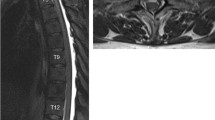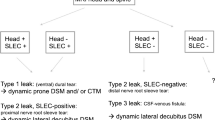Abstract
Despite profound diagnostics, the aetiology of spinal epidural haematoma (SEH) often remains unknown. In this case, diagnostics revealed an SEH at the fifth and sixth thoracic levels due to a subclavian steal syndrome with a tortuous vascular loop between the sixth thoracic intercostal artery and the costocervical arteries deriving from the left subclavian artery with plump arteries in the epidural space. The patient underwent decompression surgery and a percutaneous transluminal angioplasty. The patient showed good recovery at follow-up. The SEH was a result of secondary formed thoracic collateral circuits with epidural involvement due to a subclavian steal syndrome.




Similar content being viewed by others
References
Albert A, Hassanein W, Florath I, Voehringer L, Abugameh A, Ennker J (2008) Technical aspects of composite arterial T-grafts: estimation of required conduit length by a simple formula. Thorac Cardiovasc Surg 56(8):461–466
Bakker NA, Veeger NJGM, Vergeer RA, Groen RJM (2015) Prognosis after spinal cord and cauda compression in spontaneous spinal epidural hematomas. Neurology 84(18):1894–1903
Beatty RM, Winston KR (1984) Spontaneous cervical epidural hematoma. A consideration of etiology. J Neurosurg 61(1):143–148
Ditunno JF, Young W, Donovan WH, Creasey G (1994) The international standards booklet for neurological and functional classification of spinal cord injury. American Spinal Injury Association. Paraplegia 32(2):70–80
Frankel HL, Hancock DO, Hyslop G, Melzak J, Michaelis LS, Ungar GH, Vernon JD, Walsh JJ (1969) The value of postural reduction in the initial management of closed injuries of the spine with paraplegia and tetraplegia. I Paraplegia 7(3):179–192
Groen RJ, van Alphen HA (1996) Operative treatment of spontaneous spinal epidural hematomas: a study of the factors determining postoperative outcome. Neurosurgery 39(3):494–508, discussion 508–9
Groen RJM (2004) Non-operative treatment of spontaneous spinal epidural hematomas: a review of the literature and a comparison with operative cases. Acta Neurochir 146(2):103–110
Huang W, Gross BA, Du R (2013) Spinal extradural arteriovenous fistulas. J Neurosurg Spine 19(5):582–590
Kreppel D, Antoniadis G, Seeling W (2003) Spinal hematoma: a literature survey with meta-analysis of 613 patients. Neurosurg Rev 26(1):1–49
Rangel-Castilla L, Holman PJ, Krishna C, Trask TW, Klucznik RP, Diaz OM (2011) Spinal extradural arteriovenous fistulas: a clinical and radiological description of different types and their novel treatment with onyx. J Neurosurg Spine 15(5):541–549
Takai K, Taniguchi M (2012) Comparative analysis of spinal extradural arteriovenous fistulas with or without intradural venous drainage: a systematic literature review. Neurosurg Focus 32(5):E8
Wang M, Zhou P, Jiang S (2017) Clinical features, management, and prognostic factors of spontaneous epidural spinal hematoma: analysis of 24 cases. World Neurosurg. https://doi.org/10.1016/j.wneu.2017.02.058
Wu Z-Y, Zhu Y-J, Chu L, Cheng C-Y, Chen C-M, Hui-Ting H (2017) Full-endoscopic transforaminal approach for removal of a spontaneous spinal epidural hematoma. World Neurosurg 98:883.e13–883.e20
Yu J-X, Liu J, He C et al (2017) Spontaneous spinal epidural hematoma: a study of 55 cases focused on the etiology and treatment strategy. World Neurosurg 98:546–554
Acknowledgements
We would like to thank Dr. S.G. van Duinen for his contribution on the histological examination and illustration.
Funding
No funding was received for this research.
Author information
Authors and Affiliations
Corresponding author
Ethics declarations
Informed consent
Informed consent was obtained from the participant included in the study.
Conflict of interest
The authors report no conflict of interest.
Rights and permissions
About this article
Cite this article
Wettstein, R.K.R.W., van der Kallen, B.F.W., Moojen, W.A. et al. Thoracic epidural haematoma due to a subclavian steal syndrome and secondary formed thoracic collateral circuits, coincidence or consequence: a case report. Acta Neurochir 160, 205–208 (2018). https://doi.org/10.1007/s00701-017-3402-y
Received:
Accepted:
Published:
Issue Date:
DOI: https://doi.org/10.1007/s00701-017-3402-y




